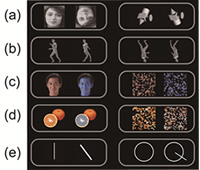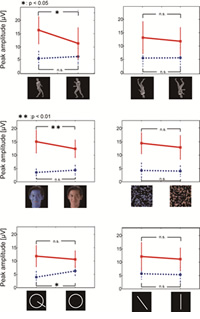Research highlights
Visual stimuli and cognitive processes: Oddball tasks and blue-colored humans
When humans see objects or hear noise created them, they not only perceive what they are but also implicitly endeavor to estimate their familiarity and naturalness to us. A positive ERP (event-related potential) component occurring 300–500 ms after the onset of a stimulus—known as P3—has been suggested to reflect various cognitive processes.
Here, Tetsuto Minami and colleagues at Electronics-Inspired Interdisciplinary Research Institute (EIIRIS) investigated the P3 component using an oddball paradigm. However, the typical oddball paradigm is inappropriate for examining stimulus familiarity and naturalness, because the difference in task difficulty and frequency between standard and target stimuli contaminates that of the stimulus property itself.
Minami and colleagues focused on the relationship between stimulus pairs and their amplitudes during oddball tasks. The participants in the experiments performed two oddball tasks replacing the target stimulus with the standard stimulus. The researchers used pairs of natural and unnatural visual stimuli: a female face and an inverted face; a human pose and an impossible pose; a natural upright face and a bluish face; a natural orange and a gray orange (Fig. 1).
As a result, the naturalness of the target stimuli differentiated the P3 amplitude: the unnatural target enhanced the P3 amplitude rather than the natural one, and elicited P3 asymmetry (Fig. 2).
The asymmetry of the P3 amplitude during an oddball task might be useful as an evaluation index for stimulus features.
- Reference:
- T. Minami1, K. Goto2, M. Kitazaki2 and S. Nakauchi2
- Asymmetry of P3 amplitude during oddball tasks reflects the unnaturalness of visual stimuli.
- Neuroreport 20 1471
- DOI: 10.1097/WNR.0b013e3283321cfb
- 1Electronics-Inspired Interdisciplinary Research Institute (EIIRIS), University of Technology, Aichi, Japan;
2Department of Computer Science and Engineering, Toyohashi University of Technology, Aichi, Japan.
- Further information and websites
- Electronics-Inspired Interdisciplinary Research Institute (EIIRIS), Toyohashi University of Technology: http://www.eiiris.tut.ac.jp/
- Toyohashi Tech Nakauchi Group: http://www.vpac.cs.tut.ac.jp/jp/index.php

Dr Minami

Fig.1: The ten pairs of stimuli used in this study

Enlarge Image
Figure 2: Peak amplitude at 380–500 ms for target–standard stimulus pairs


